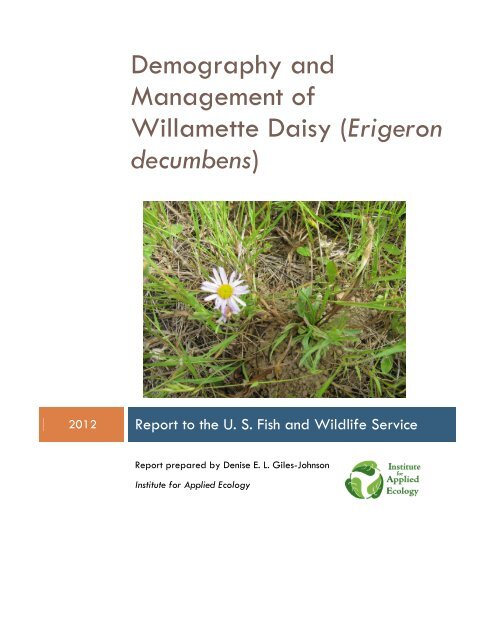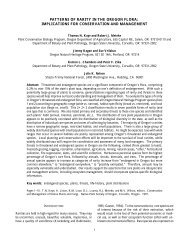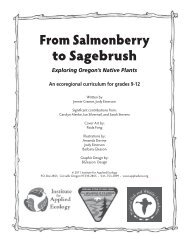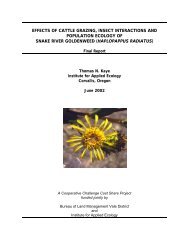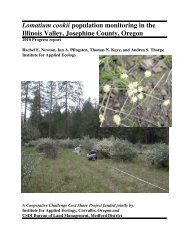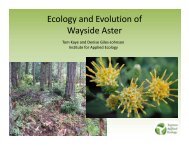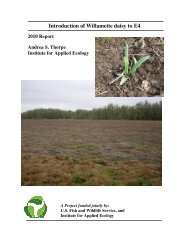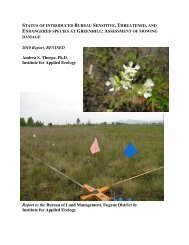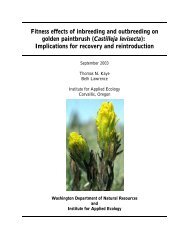Determining appropriate management techniques for Willamette ...
Determining appropriate management techniques for Willamette ...
Determining appropriate management techniques for Willamette ...
You also want an ePaper? Increase the reach of your titles
YUMPU automatically turns print PDFs into web optimized ePapers that Google loves.
Demography and<br />
Management of<br />
<strong>Willamette</strong> Daisy (Erigeron<br />
decumbens)<br />
2012 Report to the U. S. Fish and Wildlife Service<br />
Report prepared by Denise E. L. Giles-Johnson<br />
Institute <strong>for</strong> Applied Ecology
ERDE Management Progress Report, 2012<br />
Demography and Management of <strong>Willamette</strong> Daisy (Erigeron decumbens)<br />
PREFACE<br />
This report is the result of an agreement between the Institute <strong>for</strong> Applied<br />
Ecology (IAE) and a federal agency. IAE is a non-profit organization whose<br />
mission is conservation of native ecosystems through restoration, research and<br />
education. IAE provides services to public and private agencies and<br />
individuals through development and communication of in<strong>for</strong>mation on<br />
ecosystems, species, and effective <strong>management</strong> strategies. Restoration of<br />
habitats, with a concentration on rare and invasive species, is a primary focus.<br />
IAE conducts its work through partnerships with a diverse group of agencies,<br />
organizations and the private sector. IAE aims to link its community with native<br />
habitats through education and outreach.<br />
Questions regarding this report or IAE should be directed to:<br />
Thomas Kaye (Executive Director)<br />
Institute <strong>for</strong> Applied Ecology<br />
PO Box 2855<br />
Corvallis, Oregon 97339-2855<br />
phone: 541-753-3099<br />
fax: 541-753-3098<br />
email: tom@appliedeco.org<br />
ii
ERDE Management Progress Report, 2012<br />
Demography and Management of <strong>Willamette</strong> Daisy (Erigeron decumbens)<br />
ACKNOWLEDGEMENTS<br />
The authors gratefully acknowledge the cooperation provided by the USFWS, particularly Jennifer<br />
Thompson. IAE staff Michelle Allen, Geoff Gardner, Stacy Moore, Lisa VanTieghem and Shell<br />
Whittington; IAE/Native Plant Society of America interns Guy Banner and Charlotte Trowbridge, and<br />
Apprenticeship in Science and Engineering intern Eduardo Ramirez. Additional support has been<br />
provided by Jock Beall (USFWS, Finley National Wildlife Refuge), Wes Messinger (USACE Fernridge<br />
Natural Area), Trevor Taylor and Paul Gordon (City of Eugene). Matt Melethin (Integrated Resource<br />
Management) and Cody Wood assisted with <strong>management</strong> treatments.<br />
Cover photograph: Erigeron decumbens at Finley National Wildlife Refuge<br />
Suggested citation<br />
Giles-Johnson, D.E.L. 2012. Demography and Management of <strong>Willamette</strong> daisy. 2012 Progress<br />
Report. Prepared by Institute <strong>for</strong> Applied Ecology <strong>for</strong> US Fish and Wildlife Service; Corvallis,<br />
Oregon. v + 33 pp.<br />
iii
TABLE OF CONTENTS<br />
ERDE Management Progress Report, 2012<br />
Demography and Management of <strong>Willamette</strong> Daisy (Erigeron decumbens)<br />
PREFACE......................................................................................................................... II<br />
ACKNOWLEDGEMENTS ................................................................................................. III<br />
SUGGESTED CITATION .................................................................................................. III<br />
TABLE OF CONTENTS .................................................................................................... IV<br />
LIST OF FIGURES ........................................................................................................... VI<br />
LIST OF TABLES ............................................................................................................. VI<br />
INTRODUCTION ............................................................................................................. 1<br />
Management treatments ................................................................................................................. 2<br />
Demographic monitoring ................................................................................................................. 2<br />
METHODS ....................................................................................................................... 3<br />
Outplanting ........................................................................................................................................ 3<br />
Treatments .......................................................................................................................................... 4<br />
Monitoring .......................................................................................................................................... 7<br />
<strong>Willamette</strong> Daisy ........................................................................................................................... 7<br />
Community ....................................................................................................................................... 7<br />
RESULTS .......................................................................................................................... 7<br />
Outplanting Success .......................................................................................................................... 7<br />
Treatment Effects on <strong>Willamette</strong> Daisy ........................................................................................ 8<br />
Survivorship ..................................................................................................................................... 8<br />
Reproductive Success ..................................................................................................................... 9<br />
Treatment Effects on Plant Community ....................................................................................... 11<br />
Mowing ......................................................................................................................................... 15<br />
Grazing (Fern Ridge only)......................................................................................................... 15<br />
Grass-Specific Herbicide ........................................................................................................... 15<br />
Burning + Glyphosate ................................................................................................................ 15<br />
Glyphosate (Finley only)............................................................................................................ 15<br />
Carbon Addition .......................................................................................................................... 15<br />
FUTURE ACTIVITIES ...................................................................................................... 16<br />
LITERATURE CITED ....................................................................................................... 18<br />
APPENDIX A PLANTING LOCATIONS AT FINLEY NATIONAL WILDLIFE REFUGE ........ 20<br />
ERDE Management plot locations at Field 29, Finley National Wildlife Refuge .............. 20<br />
ERDE Management plot locations at Field 8N, Finley National Wildlife Refuge .............. 21<br />
Macroplot design at Finley National Wildlife Refuge. ....................................................... 22<br />
Layout of blocks and treatment plots at Finley National Wildlife Refuge. ..................... 23<br />
Treatment Map, Finley Wildlife Refuge ................................................................................. 24<br />
iv
ERDE Management Progress Report, 2012<br />
Demography and Management of <strong>Willamette</strong> Daisy (Erigeron decumbens)<br />
APPENDIX B PLANTING LOCATIONS AT FERN RIDGE NATURAL AREA..................... 25<br />
ERDE Management plot locations at Kirk East, Fern Ridge Natural Area .......................... 25<br />
ERDE Management plot locations at Applegate, Fern Ridge Natural Area ...................... 26<br />
Macroplot design at Kirk East, Fern Ridge Natural Area ................................................... 28<br />
Macroplot design at Applegate, Fern Ridge Natural Area ............................................... 29<br />
v
LIST OF FIGURES<br />
ERDE Management Progress Report, 2012<br />
Demography and Management of <strong>Willamette</strong> Daisy (Erigeron decumbens)<br />
Figure 1. Flowering individual of <strong>Willamette</strong> daisy (Erigeron decumbens). ............................................... 1<br />
Figure 2. Mow plots at Finley, Field 29 (left) and Fern Ridge, Applegate (right). At both sites mowing<br />
occurred in mid-September. ....................................................................................................................... 4<br />
Figure 3. Sheep grazing at Applegate. Sixty sheep were placed in each 14m x 14m grazing plot <strong>for</strong> 12-<br />
16 hours. ..................................................................................................................................................... 5<br />
Figure 4. Glyphosate application to a burned plot at Finley, Field 8 (left) and grass-specific herbicide at<br />
Finley, Field 29 (right). ................................................................................................................................ 6<br />
Figure 5. Burned plot at Finley Field 8, Corvallis West Recovery Zone. ..................................................... 6<br />
Figure 6. Percent survivorship from 2011-2012 at the Eugene West and Corvallis West Recovery Zones.<br />
Survivorship was higher overall at the Corvallis West sites. There was not a significant effect of<br />
treatment on survival. ................................................................................................................................ 9<br />
Figure 7. Average number of capitula at the fours sites outplanted. Note that the Eugene West sites<br />
(Applegate and Kirk East) have less capitula than the Corvallis West sites (Field 8 and Field 29). Grazing<br />
did not occur at the Corvallis Sites, the ‘Glyphosate Only’ treatment occurred only in the Corvallis West<br />
Recovery Zone. At the time of monitoring, ‘Burning + Glyphosate’ had not occurred at the Eugene sites.<br />
Error bars represent ± 1 Standard Error. Only At Finley Field 8 was there a significant response from the<br />
‘Burn + Glyphosate’ treatment resulting in more capitula per plant than the control (or any other<br />
treatment). ................................................................................................................................................ 10<br />
Figure 8. Ellipse size (cm 2 ) of <strong>Willamette</strong> Daisy at both the Eugene West and Corvallis West REcovery<br />
Zones. There was not a significant effect of any treatment on the size of the plants. As with capitula,<br />
the plants from the Corvallis West Recovery zone were consistently larger than those from the Eugene<br />
West Recovery Zoned independent of treatment. ................................................................................... 11<br />
Figure 9. Average plant cover by functional group <strong>for</strong> Erigeron decumbens outplanting sites in the<br />
Corvallis West and Eugene West Recovery Zones. ................................................................................... 12<br />
Figure 10. Percent cover of native and invasive <strong>for</strong>bs by treatment in both the Eugene and Corvallis<br />
West Recovery Zones. Error bars represent ± 1 Standard Error. ............................................................. 13<br />
Figure 11. Percent cover of native and invasive graminoid species at sites in the Eugene West and<br />
Corvallis West Recovery Zones. ................................................................................................................ 14<br />
Figure 12. Percent shrub cover in both the Eugene and Corvallis West Recovery Zones. Native and<br />
invasive species are lumped together. ..................................................................................................... 14<br />
LIST OF TABLES<br />
Table 1. Table of the number of plants, survivorship and flowering plants at each site. Data collected<br />
July 2011 (approximately 3 months after outplanting) and June 2012. .................................................... 8<br />
Table 2. Timeline of activities to determine effects of <strong>management</strong> on <strong>Willamette</strong> daisy. .................... 16<br />
vi
ERDE Management Progress Report, 2012<br />
Demography and Management of <strong>Willamette</strong> Daisy (Erigeron decumbens)<br />
Demography and Management of<br />
<strong>Willamette</strong> Daisy (Erigeron<br />
decumbens)<br />
P R O G R E S S R E P O R T T O T H E U S F I S H A N D W I L D L I F E S E R V I C E<br />
INTRODUCTION<br />
<strong>Willamette</strong> daisy (Erigeron decumbens; Figure 1) is listed<br />
as an endangered species under the Oregon and federal<br />
Endangered Species Acts (ORBIC 2010). Without direct<br />
intervention, its prospects <strong>for</strong> recovery are poor. The<br />
majority of populations are small, isolated, and found on<br />
unprotected lands. Further, natural recruitment is low due<br />
to competition with invasive weeds, altered disturbance<br />
regimes, and possible genetic issues (Thorpe and Kaye, in<br />
press). In the Recovery Plan <strong>for</strong> the Prairie Species of<br />
Western Oregon and Southwestern Washington (USFWS<br />
2010), both invasive species and improper prairie<br />
<strong>management</strong> were identified as important threats to<br />
<strong>Willamette</strong> daisy. Although <strong>management</strong> practices such<br />
as mowing, grazing, burning, thatch removal, and selective<br />
use of herbicides can be useful <strong>techniques</strong> to maintain<br />
prairie habitats and discourage invasive species (Pfeifer-<br />
Meister et al. 2007, Boyer 2008; Stanley et al. 2008;<br />
Stanley et al. 2010), applying these treatments in the<br />
Figure 1. Flowering individual of <strong>Willamette</strong> daisy (Erigeron<br />
decumbens).<br />
wrong season and/or with the wrong frequency can have detrimental impacts on native prairie species.<br />
Un<strong>for</strong>tunately, we currently have little in<strong>for</strong>mation on how <strong>Willamette</strong> daisy responds to various<br />
<strong>management</strong> activities. The goal of this project is to combine careful demographic studies with<br />
experimental habitat <strong>management</strong> treatments in order to provide in<strong>for</strong>mation on effective <strong>management</strong><br />
of this species.<br />
1
Management treatments<br />
ERDE Management Progress Report, 2012<br />
Demography and Management of <strong>Willamette</strong> Daisy (Erigeron decumbens)<br />
Mowing and prescribed fire are the two <strong>management</strong> <strong>techniques</strong> most commonly used to maintain habitat<br />
occupied by <strong>Willamette</strong> daisy. However, there is little data on the effects of these treatments on birth<br />
and death rates of the species. In a five-year study at Oxbow West, we found that compared to control<br />
plots, there tended to be fewer, but larger plants in plots that had been mowed every-other-year or<br />
burned (Thorpe and Kaye 2007). There also tended to be fewer capitula per plant in the mowed plots,<br />
suggesting that <strong>management</strong> <strong>techniques</strong> might not always have positive effects on the species. However,<br />
active <strong>management</strong> is required in most prairies to reduce the cover of invasive and woody plant species<br />
(Noss et al. 1995, Floberg et al. 2004). The focus of this study is to determine habitat <strong>management</strong><br />
<strong>techniques</strong> that will reduce the cover of invasive and woody plant species while maintaining or enhancing<br />
the cover of native species, including <strong>Willamette</strong> daisy.<br />
We will test the effectiveness of mowing, prescribed fire + glyphosate, glyphosate only (Finley only),<br />
sheep grazing, grass-specific herbicide [Fusilade (Fluazifop)], and carbon addition as habitat<br />
<strong>management</strong> <strong>techniques</strong> in habitat occupied by <strong>Willamette</strong> daisy. Thatch removal had originally been<br />
identified as a potential treatment; however thatch levels at the sites selected <strong>for</strong> this project were not<br />
sufficient to warrant this treatment. Several of these <strong>management</strong> <strong>techniques</strong> have previously been found<br />
to be effective in enhancing cover of native prairies species in the <strong>Willamette</strong> Valley/Puget<br />
Sounds/Georgia Basin ecoregion (Kirkpatrick et al. 2006; Pfeifer-Meister et al. 2007; Boyer 2008;<br />
Stanley et al. 2008; Stanley et al. 2010).<br />
Conducting these experiments in natural populations of <strong>Willamette</strong> daisy would provide the best test of<br />
how <strong>Willamette</strong> daisy populations respond to <strong>management</strong> treatments. However, few populations are<br />
large enough to allow <strong>for</strong> a replicated study and agency regulations limit the scope of treatments that<br />
can be applied. Thus, we have introduced populations of <strong>Willamette</strong> daisy to test habitat <strong>management</strong><br />
treatments at two sites each at Finely National Wildlife Refuge (USFWS) and Fern Ridge Natural Area<br />
(ACOE). In the spring of 2013 an additional four areas will be outplanted, two additional blocks at<br />
Finely National Wildlife Refuge, one at Big Spires (ACOE) and a fourth on land managed by the City of<br />
Eugene.<br />
Demographic monitoring<br />
A second objective of this study is to improve our understanding of <strong>Willamette</strong> daisy population<br />
demography. We will use demographic monitoring to determine the effects of habitat treatments on<br />
birth and death rates of <strong>Willamette</strong> daisy. Monitoring occurred in 2011 and 2012. In the introduced<br />
populations, we recorded the size (length, width, and height) and reproductive status of each individual.<br />
This protocol was followed to monitor the <strong>Willamette</strong> daisy population at Oxbow West in the West<br />
Eugene Wetlands <strong>for</strong> eight years (Thorpe and Kaye 2007). As in 2011-12, in 2013 and 2014, we will<br />
survey surrounding areas <strong>for</strong> new individuals. All individuals will be mapped and assigned unique<br />
numbers in order to track yearly changes in individual characteristics and estimate birth and death rates.<br />
We will note the presence or absence of grazing <strong>for</strong> each individual.<br />
In 2011, we also conducted monitoring at several introduced and natural populations throughout the<br />
<strong>Willamette</strong> Valley. The intent of this project was to determine (1) recruitment of new <strong>Willamette</strong> daisy<br />
individuals into introduced populations, and (2) factors impacting recruitment rates. This research was<br />
2
ERDE Management Progress Report, 2012<br />
Demography and Management of <strong>Willamette</strong> Daisy (Erigeron decumbens)<br />
conducted as a MS thesis by Katie Gallagher, at Oregon State University and will be included in the<br />
final report.<br />
METHODS<br />
Plugs <strong>for</strong> outplanting in 2011 were produced in fall 2010 – spring 2011 using seed from two Recovery<br />
Zones, Corvallis West (Allen and Allen/Muddy Creek), and Eugene West (Balboa and Oxbow West<br />
populations). In September of 2010, seeds were placed in germination trays and then placed into 16<br />
weeks of cold stratification at 6°C. Seeds were checked weekly and misted with distilled water to keep<br />
them moist. If any mold was present, damaged seeds were removed and a solution of distilled water and<br />
hydrogen peroxide was sprayed on the seeds. The seeds were removed from cold stratification and<br />
placed in a room with a 25 o C day / 15 o C night temperature cycle and 8 h day / 16 h night lighting<br />
cycle one week prior to planting into conetainers. Plants were planted into conetainers 3.81cm wide and<br />
13.97cm deep in trays of 98 and kept at the OSU West Greenhouse. Pots were filled with Gardner’s<br />
Gold potting soil and placed in a greenhouse maintained at 21 o C during the day and 13 o C at night with<br />
14 hour daily artificial light provided by Sun System 3 - 400 HPS bulbs. Pots were watered from the<br />
bottom 1-4 times per week as necessary. An 8-8-8 fertilizer was sprayed weekly on the plants and then<br />
rinsed off to prevent burnt leaves. At approximately eight weeks, the plants were inoculated with<br />
nematodes to prevent fungus gnats from attacking the young plants. One week prior to outplanting, all<br />
pots were placed outside to harden-off. The same procedure was followed in 2012-2013 <strong>for</strong> the plants<br />
to be outplanted in the spring of 2013.<br />
Outplanting<br />
In April 2011, 900 plants were outplanted at Finley National Wildlife Refuge (Finley); 450 each in Field<br />
29 and Field 8 North (Appendix A). Finley is located approximately 16 km south of Corvallis, Oregon, in<br />
the Benton West Recovery Zone (USFWS 2010). Historical records indicated that this Refuge once hosted<br />
a <strong>Willamette</strong> daisy population, but the population has not been observed since the 1990’s. In 2007 and<br />
2008, <strong>Willamette</strong> daisy was introduced to four sites at Finley, including 174 at Field 29. Plots <strong>for</strong> this<br />
experiment were located approximately 30m from the 2007 and 2008 introductions. Field 29 and Field<br />
8 North were selected because of their relatively low cover of exotic plants, general habitat suitability<br />
<strong>for</strong> <strong>Willamette</strong> daisy, and ease of access <strong>for</strong> <strong>management</strong>. Both sites have been under active restoration<br />
and <strong>management</strong> (including herbicide treatments, mowing, and seeding) by USFWS.<br />
At each site, three 14m x 22m blocks were marked with rebar pounded flush with the ground and<br />
topped with an orange cap. The three blocks are adjacent, and the NW corner of the macroplot was<br />
marked with a T-post. Within each block there were six 6m x 6m treatment plots, marked with 8” nails<br />
pushed flush with the soil surface and capped with marking whiskers. There is a two meter buffer<br />
between each treatment square. <strong>Willamette</strong> daisy plugs were planted along a 5m x 5m grid in the<br />
center of each treatment plot (25 plants per plot) (Appendix A, Appendix B).<br />
At Fern Ridge Natural Area, 716 plants were outplanted, 360 at Applegate, and 356 at Kirk NE, in<br />
April 2011 (Appendix B). Fern Ridge Natural Area is located approximately 60km south of Corvallis,<br />
Oregon in the Eugene West Recovery Zone (USFWS 2010), and is managed by the Army Corps of<br />
Engineers (ACOE). Applegate and Kirk East were selected because of habitat suitability <strong>for</strong> <strong>Willamette</strong><br />
3
ERDE Management Progress Report, 2012<br />
Demography and Management of <strong>Willamette</strong> Daisy (Erigeron decumbens)<br />
daisy and ease of access <strong>for</strong> <strong>management</strong>. Both sites have been under active restoration and<br />
<strong>management</strong> including mowing and invasive weed removal by the ACOE.<br />
We used 144 plants from the ACOE in the outplanting in addition to the plants grown by IAE. Four of<br />
these plants and 16 of the plants grown by IAE were planted per plot. Although the plants from the<br />
ACOE were smaller, they had robust root structure. At each site, three 14m x 38m blocks were marked<br />
with fiberglass poles at each corner. Within each block there were six 6m x 6m treatment plots, marked<br />
with 8” nails topped with marking whiskers. Due to low germination and survival of Eugene West plants<br />
in the greenhouse, we had to reduce both the number of individuals planted in each plot and the number<br />
of treatments. Thus, one of the seven blocks was randomly excluded from planting. In the remaining<br />
treatment plots, <strong>Willamette</strong> daisy plugs were planted along a 5m x 5m grid in the center of each<br />
treatment plot, with the exception that one row or column was skipped so that 20 plants were in each<br />
square. Each block also contained a 14m x 14m grazing plot; within this plot, plugs were also planted<br />
along a 5m x 5m grid in the center of each treatment plot, with the exception that a one row or column<br />
was skipped so that 20 plants were in each square.<br />
Treatments<br />
The habitat <strong>management</strong> treatments tested include; mowing, prescribed fire + glyphosate, glyphosate<br />
only (Finley only), sheep grazing (Fern Ridge only), grass-specific herbicide (Fusilade), and carbon<br />
addition. Several of these <strong>management</strong> <strong>techniques</strong> have previously been found to be effective in<br />
enhancing cover of native prairies species in the <strong>Willamette</strong> Valley/Puget Sounds/Georgia Basin<br />
ecoregion (Kirkpatrick et al. 2006; Pfeifer-Meister et al. 2007; Boyer 2008; Stanley et al. 2008;<br />
Stanley et al. 2010). Community cover was estimated in three 1m 2 plots in the spring of 2012.<br />
Mowing<br />
Mowing was per<strong>for</strong>med in September 2011. The sites were evaluated in February 2012 and it was<br />
determined that a second mowing treatment was not necessary. At Fern Ridge mowing was per<strong>for</strong>med<br />
by ACOE staff with a tractor. At Finley, the plots were mowed with a weedeater. Fall mowing reduces<br />
thatch accumulation and cuts back fall-growing grasses. Mowing height was 2-4”; plant material was left<br />
on site (Figure 2Figure 2). Mowing will be repeated in 2013.<br />
Figure 2. Mow plots at Finley, Field 29 (left) and Fern Ridge, Applegate (right). At both sites mowing occurred in mid-September.<br />
4
ERDE Management Progress Report, 2012<br />
Demography and Management of <strong>Willamette</strong> Daisy (Erigeron decumbens)<br />
Sheep Grazing (Fern Ridge only)<br />
Sheep grazing occurred in the 14m x 14m treatment plots in October 2012. While most native species<br />
are dormant in October, several exotic species are green this time of year, which potentially gives them<br />
a competitive advantage the following spring. Approximately 60 sheep were placed in each of the<br />
grazing plots until there was no longer suitable <strong>for</strong>age (12 to 16 hours). Grazing will occur at all Eugene<br />
sites in 2013.<br />
Figure 3. Sheep grazing at Applegate. Sixty sheep were placed in each 14m x 14m grazing plot <strong>for</strong> 12-16 hours.<br />
Grass-specific Herbicide<br />
A grass-specific herbicide [Fusilade, (Fluazifop)], was applied in early November at a rate of<br />
28oz./acre to treatment plots at both Fern Ridge and Finley to reduce abundance of exotic grasses. This<br />
treatment will occur at all sites in 2013.<br />
5
ERDE Management Progress Report, 2012<br />
Demography and Management of <strong>Willamette</strong> Daisy (Erigeron decumbens)<br />
Figure 4. Glyphosate application to a burned plot at Finley, Field 8 (left) and grass-specific herbicide at Finley, Field 29 (right).<br />
Burning + Glyphosate<br />
Burning at Finley occurred on September 20 th , 2011 (Figure 5) and the spray of glyphosate<br />
(Aquamaster) occurred one month post-burn with a concentration of 3%. The sites were evaluated two<br />
weeks post-burn and there had not yet been significant resprout of invasive species. At the time of<br />
herbicide treatment, one month post-burn, vegetation was dominated by invasive species. Burning at Fern<br />
Ridge did not occur in 2011. On October 9 th , 2012 the Fern Ridge plots were burned and a 3%<br />
application of glyphosate followed on October 26 th . Fall burning reduces biomass and thatch<br />
accumulation and post-burn glyphosate (a broad-spectrum herbicide) application reduces abundance of<br />
broad-leaf weeds. This last treatment was developed based on observations that non-native species<br />
resprout more quickly after fire than do most native species. This treatment is scheduled to be repeated<br />
at all sites in 2013.<br />
Figure 5. Burned plot at Finley Field 8, Corvallis West Recovery Zone.<br />
6
ERDE Management Progress Report, 2012<br />
Demography and Management of <strong>Willamette</strong> Daisy (Erigeron decumbens)<br />
Glyphosate (Finley only)<br />
A broad-spectrum herbicide treatment was implemented in late fall at the Finley sites. Because most<br />
native plants are dormant at this time this spray is expected to target mostly non-native species. A 3%<br />
solution of glyphosate (Aquamaster) was applied to selected treatment plots. This treatments is<br />
scheduled to be repeated in 2013 at all Finley sites.<br />
Carbon Addition<br />
In March 2012, we spread 2 kg of carbon m -2 (in the <strong>for</strong>m of sucrose) on selected test plots. Carbon<br />
addition limits the amount of soil nutrients available <strong>for</strong> plant growth (particularly nitrogen and<br />
phosphorus) by stimulating microbial activity. Several studies have indicated that native species are more<br />
capable of tolerating low nutrient conditions than exotic species (Morgan 1994, Reever Morghan and<br />
Seastedt 1999, Alpert and Maron 2000, Blumenthal et al. 2003, Kirkpatrick et al. unpublished data). This<br />
treatment is scheduled to occur at all sites in 2013.<br />
Monitoring<br />
<strong>Willamette</strong> Daisy<br />
Survival and growth of all plants was monitored in June 2011 and June 2012. For each individual, we<br />
measured the widest diameter of a plant (the outermost part of an individual, including flowers), the<br />
diameter perpendicular to the widest diameter, height, and number of capitula (flower heads). The<br />
shape of each plant was assumed to be oval, and the maximum diameter and perpendicular diameter<br />
were used to calculate the elliptical crown cover of each plant as per equation 1.<br />
Equation 1. Elliptical crown cover = (0.5*widest diameter) * (0.5*perpendicular diameter) * π<br />
Community<br />
Ocular estimates of cover of all plant species were per<strong>for</strong>med in each treatment block in June 2012 (at<br />
the time of daisy monitoring). In each treatment square, three 1m 2 plots were measured; at least 54 1m 2<br />
blocks were monitored at each site.<br />
RESULTS<br />
Outplanting Success<br />
In the first year following outplanting survivorship was high at all sites. Survivorship ranged from 92%<br />
at Kirk East to 95% at Field 29 (Table 1). The areal cover of plants varied by site in both 2011 and<br />
2012; plants were larger at the Finley sites than at Fern Ridge and produced more capitula (Table 1,<br />
Figure 7 ). Survivorship from 2012-2013 ranged from 32% to 94%. Overall plants from the Corvallis<br />
West Recovery Zone flowered more often and were larger than their counterparts from the Eugene West<br />
Recovery Zone. In the Eugene West Recovery Zone plants at Kirk East were consistently larger than those<br />
at Applegate (Table 1, Figure 8).<br />
7
ERDE Management Progress Report, 2012<br />
Demography and Management of <strong>Willamette</strong> Daisy (Erigeron decumbens)<br />
Table 1. Table of the number of plants, survivorship and flowering plants at each site. Data collected July 2011 (approximately 3 months after<br />
outplanting) and June 2012.<br />
Corvallis West<br />
Finley<br />
Eugene West<br />
Fern Ridge<br />
Field 8 Field 29 Applegate Kirk<br />
Number outplanted in 2011 450 450 360 356<br />
2011 Number (%) survival 426 (94.7%) 428 (95.1%) 342 (95.0%) 327 (91.9%)<br />
2011 Number flowering 2 6 1 0<br />
2011 Average size (cm 2 ) 67 81 31 45<br />
2012 Number (%) survival<br />
(2011-2012)<br />
347 (81.4%) 365 (85.2%) 144 (42.1%) 198 (60.5%)<br />
2012 Number flowering 195 (56.2%) 240 (65.8%) 60 (41.7%) 86 (43.4%)<br />
2012 Average size (cm 2 ) 249 239 158 211<br />
Treatment Effects on <strong>Willamette</strong> Daisy<br />
Survivorship<br />
Survivorship varied by site, however there were no significant treatment effects on the survivorship of<br />
<strong>Willamette</strong> daisy. In the Eugene West Recovery Zone, survivorship ranged from 32-72% and in the<br />
Corvallis West from 63-94%. The lack of treatment effects on survival of <strong>Willamette</strong> daisy can be<br />
interpreted as an indication that though endangered, <strong>Willamette</strong> daisy can handle aggressive<br />
<strong>management</strong> treatments without any significant detrimental effects. Monitoring in 2013-2015 will track<br />
longer term effects on the daisies that may not yet be evident. Additionally, burning did not occur at the<br />
Eugene West sites until the fall of 2012 so the effects of Burn + Glyphosate treatment in the Eugene<br />
West Recovery Zone are still unknown.<br />
8
ERDE Management Progress Report, 2012<br />
Demography and Management of <strong>Willamette</strong> Daisy (Erigeron decumbens)<br />
Figure 6. Percent survivorship from 2011-2012 at the Eugene West and Corvallis West Recovery Zones. Survivorship was higher overall at the Corvallis<br />
West sites. There was not a significant effect of treatment on survival.<br />
Reproductive Success<br />
Initial monitoring in 2012 indicates that only one treatment at one site had a significant effect on the<br />
reproductive success of <strong>Willamette</strong> daisy: the Burn + Glyphosate treatment at Finely, Field 29 (Corvallis<br />
West Recovery Zone), had significantly more flowers than the control (Figure 6).<br />
9
ERDE Management Progress Report, 2012<br />
Demography and Management of <strong>Willamette</strong> Daisy (Erigeron decumbens)<br />
Figure 7. Average number of capitula at the fours sites outplanted. Note that the Eugene West sites (Applegate and Kirk East) have less capitula than<br />
the Corvallis West sites (Field 8 and Field 29). Grazing did not occur at the Corvallis Sites, the ‘Glyphosate Only’ treatment occurred only in the<br />
Corvallis West Recovery Zone. At the time of monitoring, ‘Burning + Glyphosate’ had not occurred at the Eugene sites. Error bars represent ± 1<br />
Standard Error. Only At Finley Field 8 was there a significant response from the ‘Burn + Glyphosate’ treatment resulting in more capitula per plant<br />
than the control (or any other treatment).<br />
10
ERDE Management Progress Report, 2012<br />
Demography and Management of <strong>Willamette</strong> Daisy (Erigeron decumbens)<br />
Figure 8. Ellipse size (cm 2 ) of <strong>Willamette</strong> Daisy at both the Eugene West and Corvallis West REcovery Zones. There was not a significant effect of any<br />
treatment on the size of the plants. As with capitula, the plants from the Corvallis West Recovery zone were consistently larger than those from the<br />
Eugene West Recovery Zoned independent of treatment.<br />
Treatment Effects on Plant Community<br />
The initial site conditions differ between the Corvallis and Eugene sites. Sites at Finley Wildlife Refuge<br />
are dominated by invasive <strong>for</strong>bs whereas sites at Fern Ridge are dominated by invasive grasses. Below<br />
is an average of site conditions across all plots. Data was recorded in the spring of 2012 and here is<br />
presented as an average across all treatment blocks.<br />
The dominant vegetation at Fern Ridge (Eugene West Recovery Zone) is invasive grasses with an average<br />
cover of 61.6% and invasive <strong>for</strong>b cover of 10.4%. Dominant invasive grasses at Fern Ridge include the<br />
perennial species Anthoxanthum odoratum and Agrostis stolonifera each with an average of 30% cover,<br />
additional invasive species include Festuca arundinacea and Panicum occidentale. Annual invasive grasses<br />
at Fern Ridge have very low cover. Native grass cover was only 9.2% with 5.4% represented by<br />
Danthonia cali<strong>for</strong>nica. Average native <strong>for</strong>b cover at Fern Ridge is 5.7% and was dominantly attributed<br />
to Fragaria virginiana and Aster hallii. Invasive <strong>for</strong>b cover has an average of 10.4% cover and is<br />
dominated by Hypochaeris radicata (4.5%), Plantago lanceolata (2%) and Leucanthemum vulgare (1%).<br />
11
ERDE Management Progress Report, 2012<br />
Demography and Management of <strong>Willamette</strong> Daisy (Erigeron decumbens)<br />
Tree and shrub cover is relatively high at the Fern Ridge sites with an average cover of 13.3%; dominant<br />
species include Rosa sp. (8%), Cytisus scoparius (2.2%) and Rubus armeniacus (2.2%) (Figure 9).<br />
At Finley National Wildlife Refuge (Corvallis West Recovery Zone) the sites are dominated by invasive<br />
<strong>for</strong>b cover with an average of 63.2% and only 30.9% cover of invasive graminoids. Tree and shrub<br />
cover is relatively low with only 1.7% cover of mostly Rubus armeniacus. The dominant invasive <strong>for</strong>b<br />
species as at Fern Ridge is Hypochaeris radicata, with an average cover of 52.3%. Native <strong>for</strong>b cover is<br />
15.8 and is dominated by Eriophyllum lanatum (8.6%), Lupinus sp. (3.9%), and Potentilla gracilis (2.0%).<br />
Average Plant Cover<br />
70.0<br />
60.0<br />
50.0<br />
40.0<br />
30.0<br />
20.0<br />
10.0<br />
0.0<br />
Corvallis West<br />
Eugene West<br />
Figure 9. Average plant cover by functional group <strong>for</strong> Erigeron decumbens outplanting sites in the Corvallis West and Eugene West Recovery Zones.<br />
The results listed below are preliminary, as with many <strong>management</strong> treatments, the plant community<br />
response may take time to be detected. Additionally, it is not uncommon <strong>for</strong> multiple treatments to be<br />
applied be<strong>for</strong>e response can be detected. Repeated treatments as well as continued monitoring will<br />
enable us to detect longer term changes in both the plant community and success of <strong>Willamette</strong> daisy<br />
individuals.<br />
12
ERDE Management Progress Report, 2012<br />
Demography and Management of <strong>Willamette</strong> Daisy (Erigeron decumbens)<br />
Figure 10. Percent cover of native and invasive <strong>for</strong>bs by treatment in both the Eugene and Corvallis West Recovery Zones. Error bars represent ± 1<br />
Standard Error.<br />
13
ERDE Management Progress Report, 2012<br />
Demography and Management of <strong>Willamette</strong> Daisy (Erigeron decumbens)<br />
Figure 11. Percent cover of native and invasive graminoid species at sites in the Eugene West and Corvallis West Recovery Zones.<br />
50.0<br />
40.0<br />
30.0<br />
20.0<br />
10.0<br />
0.0<br />
Eugene<br />
Corvallis<br />
Figure 12. Percent shrub cover in both the Eugene and Corvallis West Recovery Zones. Native and invasive species are lumped together.<br />
14
Mowing<br />
ERDE Management Progress Report, 2012<br />
Demography and Management of <strong>Willamette</strong> Daisy (Erigeron decumbens)<br />
As of 2012, mowing did not have a significant effect on graminoid or <strong>for</strong>b cover (native or invasive) in<br />
either Recovery Zone. Shrub cover in the Eugene West Recovery Zone decreased with mowing.<br />
Grazing (Fern Ridge only)<br />
Based on data collected in 2012, sheep grazing in the Eugene West Recovery did not have a significant<br />
effect on graminoid or <strong>for</strong>b cover (native or invasive). Shrub cover decreased significantly in plots<br />
grazed by sheep. Mowing also decreased cover of shrubby species in the Eugene West Recovery Zone.<br />
Grass-Specific Herbicide<br />
Based on 2012 data, the application of a grass specific herbicide decreased cover of invasive<br />
graminoid species in both Recovery Zones; native graminoid cover was not affected. The application of<br />
grass-specific herbicide increased shrub cover in the Eugene West Recovery Zone.<br />
Burning + Glyphosate<br />
The application of a broad-spectrum herbicide after the first flush of green-up post-burn decreased<br />
cover of invasive grasses and invasive <strong>for</strong>bs in the Corvallis West Recovery Zone; native graminoids and<br />
<strong>for</strong>bs were not affected. Burning occurred in the Fall of 2012 at Eugene West sites.<br />
Glyphosate (Finley only)<br />
As of 2012, the application of glyphosate in the fall had no effect on the cover of native or invasive<br />
species.<br />
Carbon Addition<br />
As of 2012, carbon addition had no effect on the cover of native or invasive species.<br />
15
ERDE Management Progress Report, 2012<br />
Demography and Management of <strong>Willamette</strong> Daisy (Erigeron decumbens)<br />
FUTURE ACTIVITIES<br />
The activities reported here are part of a 2-phase, 6-year project (Table 2). In Phase 1, we have<br />
proposed to introduce populations of <strong>Willamette</strong> daisy, implement 2 years of habitat treatments, and<br />
monitor the effects on <strong>Willamette</strong> daisy and surrounding vegetation. In Phase 2, we plan to continue<br />
monitoring these populations and use the in<strong>for</strong>mation gained from Phase 1 to implement treatments to<br />
both natural and introduced populations at these and other sites.<br />
Table 2. Timeline of activities to determine effects of <strong>management</strong> on <strong>Willamette</strong> daisy.<br />
Project Element Timeframe Description<br />
Phase 1<br />
Complete site selection and<br />
experimental design<br />
Seed collection and<br />
cleaning<br />
Growout<br />
Introduce <strong>Willamette</strong> daisy<br />
Demographic, population,<br />
and community monitoring<br />
Implement <strong>management</strong><br />
treatments<br />
Spring ’10, Complete<br />
July – Aug ‘10, Complete<br />
July – Aug ’11, Complete<br />
Oct ‘10 – April ’11, Complete<br />
Oct ‘12 – April ’13 1 , In progress<br />
April ‘11, Complete<br />
April ’13 1 , Planned<br />
May - June ‘11, Complete<br />
May - June ‘12, Complete<br />
Fall ‘11 – Spring ’12 Complete<br />
Fall ’13 - Spring ’14 1<br />
Planned<br />
Fern Ridge Natural Area (ACOE) and<br />
Finley National Wildlife Refuge (USFWS)<br />
selected <strong>for</strong> introductions and experiments.<br />
As needed, we will collect seed from<br />
natural populations to augment seed<br />
currently in production.<br />
<strong>Willamette</strong> daisy grow-out will include<br />
four months of cold stratification, then<br />
propagation of seedlings in our<br />
greenhouse located at Oregon State<br />
University.<br />
Outplant seedlings.<br />
Monitoring will include demographic and<br />
population monitoring of <strong>Willamette</strong> daisy<br />
and cover estimate of all species.<br />
Mowing, grazing, and herbicide treatments<br />
will occur in the late summer/early fall.<br />
damage. Fall burning will be implemented<br />
using propane torches. Carbon addition<br />
will be implanted in the spring. Each<br />
treatment will occur twice. (Once in<br />
2011/12 and again in 2013/2014)<br />
Project and fiscal oversight ongoing On-going through-out project.<br />
16
Status reporting ‘13 –‘14<br />
Phase 2<br />
Adapt and implement<br />
methods at new sites<br />
Demographic, population,<br />
and community monitoring<br />
ERDE Management Progress Report, 2012<br />
Demography and Management of <strong>Willamette</strong> Daisy (Erigeron decumbens)<br />
Spring and Fall ‘13, ‘14, Planned<br />
May - June ‘13, ‘14, ‘15, Planned<br />
Prepare reports and communicate results<br />
through the IAE webpage and meetings.<br />
We will use the in<strong>for</strong>mation obtained from<br />
Phase 1 of this project to guide<br />
implementation of <strong>management</strong> treatments<br />
at existing populations and new<br />
introduction sites.<br />
Monitoring will include demographic and<br />
population monitoring of <strong>Willamette</strong> daisy<br />
and cover estimate of all species.<br />
Project and fiscal oversight ongoing On-going through-out project.<br />
Post-Implementation status<br />
reporting<br />
1 Dates altered relative to original proposal.<br />
‘15 – ‘16, Planned We will prepare reports and communicate<br />
results through the IAE webpage, meetings,<br />
and conferences.<br />
17
LITERATURE CITED<br />
ERDE Management Progress Report, 2012<br />
Demography and Management of <strong>Willamette</strong> Daisy (Erigeron decumbens)<br />
Alpert, P., and J.L, Maron. 2000. Carbon addition as a countermeasure against biological invasion by<br />
plants. Biological Invasions, 2, 33-40.<br />
Boyer, L. 2008. Krautmann Jefferson Farm oak and prairie habitat restoration Project. LIP progress<br />
report 2. Available at http://www.heritageseedlings.com/stewardship.htm<br />
Blumenthal, D.M., N.R. Jordan, and M.P. Russelle. 2003. Soil carbon addition controls weeds and<br />
facilitates prairie restoration. Ecological Applications, 13, 605-615.<br />
Floberg, J., M. Goering, G. Wilhere, C. MacDonald, C. Chappell, C. Rumsey, Z. Ferdana, A. Holt, P.<br />
Skidmore, T. Horsman, E. Alverson, C. Tanner, M. Bryer, P. Iachetti, A. Harcombe, B. McDonald, T.<br />
Cook, M. Summers, D. Rolph. 2004. <strong>Willamette</strong> Valley-Puget Trough-Georgia Basin Ecoregional<br />
Assessment, Volume One: Report. Prepared by The Nature Conservancy with support from the<br />
Nature Conservancy of Canada, Washington Department of Fish and Wildlife, Washington<br />
Department of Natural Resources (Natural Heritage and Nearshore Habitat programs), Oregon<br />
State Natural Heritage In<strong>for</strong>mation Center and the British Columbia Conservation Data Centre.<br />
Kirkpatrick, H., E. Spear, E. Donnelly. 2006. Soil nitrate reduction using biomass removal and sucrose<br />
addition in western Washington prairie soils. Ecological Society of America Annual Meeting.<br />
Memphis, Tennessee. Poster presentation.<br />
Morgan, J.P. 1994. Soil impoverishment: a little-known technique holds promise <strong>for</strong> establishing prairie.<br />
Restoration and Management Notes, 12, 55-56.<br />
Noss R.F., E.T. I. LaRoe, and J.M. Scott. 1995. Endangered ecosystems of the U.S.: a preliminary<br />
assessment of loss and degradation. Washington, D. C.: U.S. Department of the Interior, National<br />
Biological Service.<br />
[ORBIC] Oregon Biodiversity In<strong>for</strong>mation Center. 2010. Rare, threatened and endangered species of<br />
Oregon. Portland (OR): Institute <strong>for</strong> Natural Resources, Portland State University. 105 p.<br />
Pfeifer-Meister, L., S. D. Bridgham, B. A. Roy, and B. Johnson. 2007. Testing the effectiveness of site<br />
preparation <strong>techniques</strong> <strong>for</strong> wetland prairie restoration. City of Eugene, Eugene, Oregon.<br />
Reever Morghan, K.J., and T.R. Seastedt. 1999. Effects of soil nitrogen reduction on nonnative plants in<br />
restored grasslands. Restoration Ecology, 7, 51-55.<br />
Stanley, A.G., T.N. Kaye, and P.W. Dunwiddie. 2008. Regional strategies <strong>for</strong> restoring native prairies:<br />
observations from a multisite collaborative research project. Native Plants Journal 9:255-266.<br />
Stanley, A. G., P. Dunwiddie, and T. N. Kaye. 2010. Regional strategies <strong>for</strong> restoring invaded prairies,<br />
final technical report Institute <strong>for</strong> Applied Ecology and The Nature Conservancy, Corvallis,<br />
Oregon.<br />
Thorpe, A.S., and T.N. Kaye. 2011. Issues in the conservation and introduction of the endangered<br />
Erigeron decumbens: seed viability and the influence of local adaptation. Native Plants Journal<br />
12:289-298.<br />
18
ERDE Management Progress Report, 2012<br />
Demography and Management of <strong>Willamette</strong> Daisy (Erigeron decumbens)<br />
Thorpe, A.S, and T.N. Kaye. 2007. Erigeron decumbens ssp. decumbens (<strong>Willamette</strong> daisy): population<br />
monitoring and evaluation of mowing and burning at Oxbow West (West Eugene Wetlands).<br />
Institute <strong>for</strong> Applied Ecology, Corvallis, Oregon and USDI Bureau of Land Management, Eugene<br />
District. iii + 26pp.<br />
[USFWS] U.S. Fish and Wildlife Service. 2010. Draft Recovery Plan <strong>for</strong> the Prairie Species of Western<br />
Oregon and Southwestern Washington. U.S. Fish and Wildlife Service, Portland, Oregon. x +<br />
212 pp.<br />
19
ERDE Management Progress Report, 2012<br />
Demography and Management of <strong>Willamette</strong> Daisy (Erigeron decumbens)<br />
APPENDIX A PLANTING LOCATIONS AT FINLEY NATIONAL WILDLIFE REFUGE<br />
ERDE Management plot locations at Field 29, Finley National Wildlife<br />
Refuge<br />
Driving Directions:<br />
Drive south on Bellfountain Rd.<br />
Enter Finley Wildlife Refuge (left turn).<br />
Drive 1.1 miles and turn into the Woodpecker Loop Trail parking lot (the plots will be on your left as you<br />
drive in.) There are many other plots in the vicinity (CALE and old ERDE plots).<br />
20
ERDE Management Progress Report, 2012<br />
Demography and Management of <strong>Willamette</strong> Daisy (Erigeron decumbens)<br />
ERDE Management plot locations at Field 8N, Finley National Wildlife<br />
Refuge<br />
Driving Directions:<br />
Drive South on 99W.<br />
Turn right onto Bruce Road (at RFP Market and Gas Station).<br />
Drive 1.1 miles and enter gate on right. (See project notes <strong>for</strong> code.) There is an overlook to the left.<br />
Follow road 0.8 miles and park on side of road where it veers hard to the right.<br />
The site is at the base of Pigeon Butte and adjacent to a field currently being farmed <strong>for</strong> grass seed.<br />
21
Macroplot design at Finley National Wildlife Refuge.<br />
ERDE Management Progress Report, 2012<br />
Demography and Management of <strong>Willamette</strong> Daisy (Erigeron decumbens)<br />
Blocks at both Field 29 and Field 8 were placed adjacent to each other. The origin is marked with a Tpost<br />
and the remaining corners are marked with rebar topped with orange caps pounded flush with the<br />
ground.<br />
22
ERDE Management Progress Report, 2012<br />
Demography and Management of <strong>Willamette</strong> Daisy (Erigeron decumbens)<br />
Layout of blocks and treatment plots at Finley National Wildlife Refuge.<br />
23
Treatment Map, Finley Wildlife Refuge<br />
ERDE Management Progress Report, 2012<br />
Demography and Management of <strong>Willamette</strong> Daisy (Erigeron decumbens)<br />
24
ERDE Management Progress Report, 2012<br />
Demography and Management of <strong>Willamette</strong> Daisy (Erigeron decumbens)<br />
APPENDIX B PLANTING LOCATIONS AT FERN RIDGE NATURAL AREA<br />
ERDE Management plot locations at Kirk East, Fern Ridge Natural Area<br />
Driving Directions:<br />
Drive south on 99W towards Eugene.<br />
Turn right onto Clear Lake Road.<br />
Drive 5.9 miles and turn right onto Orchard Rd. Immediately pull into the parking area.<br />
Walk along the path, veer off the trail where it makes a hard left and continue straight through the field<br />
to the treatment blocks. Blocks are marked with fiberglass at the four corners and bamboo poles with pin<br />
flags.<br />
25
ERDE Management Progress Report, 2012<br />
Demography and Management of <strong>Willamette</strong> Daisy (Erigeron decumbens)<br />
ERDE Management plot locations at Applegate, Fern Ridge Natural Area<br />
Driving Directions:<br />
Take Territorial Highway South (either from Monroe, or Clear Lake Rd.)<br />
From the intersection of Clear Lake Rd. and Territorial continue <strong>for</strong> 3.3 miles (nearly to outskirts of Elmira).<br />
Park at ACOE parking lot and walk to plots (you can see Block 3 from the parking lot).<br />
26
ERDE Management Progress Report, 2012<br />
Demography and Management of <strong>Willamette</strong> Daisy (Erigeron decumbens)<br />
27
Macroplot design at Kirk East, Fern Ridge Natural Area<br />
ERDE Management Progress Report, 2012<br />
Demography and Management of <strong>Willamette</strong> Daisy (Erigeron decumbens)<br />
During set-up and treatments, the corners of each block is marked with a fiberglass post. And. In the intervening times, plots are only marked<br />
with 8 inch nails and colored whiskers in order to minimize visibility.<br />
28
Macroplot design at Applegate, Fern Ridge Natural Area<br />
ERDE Management Progress Report, 2012<br />
Demography and Management of <strong>Willamette</strong> Daisy (Erigeron decumbens)<br />
During set-up and treatments, the origin of each block is marked with a T-post and the remaining corners are marked with rebar topped with<br />
orange caps pounded flush with the ground. In the intervening times, plots are only marked with 8 inch nails and colored whiskers in order to<br />
minimize visibility. Map not to scale; there is greater distance between Block 3 and the remaining blocks than indicated on the map.<br />
29
Map of treatments applied at Applegate<br />
ERDE Management Progress Report, 2012<br />
Demography and Management of <strong>Willamette</strong> Daisy (Erigeron decumbens)<br />
30
Macroplot design at Kirk East, Fern Ridge Natural Area.<br />
ERDE Management Progress Report, 2012<br />
Demography and Management of <strong>Willamette</strong> Daisy (Erigeron decumbens)<br />
During set-up and treatments, the corners of each block is marked with a fiberglass post. And. In the intervening times, plots are only marked<br />
with 8 inch nails and colored whiskers in order to minimize visibility.<br />
31
Map of treatments applied at Kirk East<br />
ERDE Management Progress Report, 2012<br />
Demography and Management of <strong>Willamette</strong> Daisy (Erigeron decumbens)<br />
32
Layout of blocks and treatment plots at Fernridge Natural Area.<br />
ERDE Management Progress Report, 2012<br />
Demography and Management of <strong>Willamette</strong> Daisy (Erigeron decumbens)<br />
One small treatment plot was randomly excluded from planting, as was one planting row or column within each plot.<br />
33


